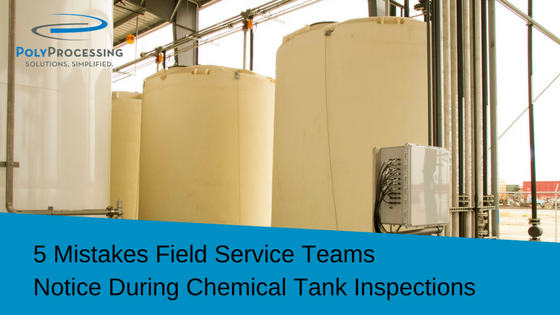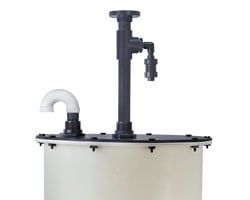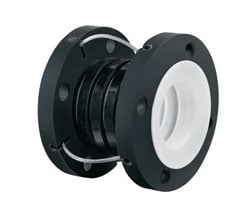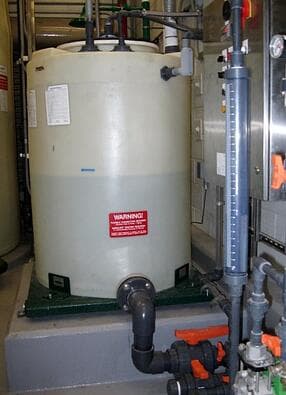5 Mistakes Field Service Teams Notice During Chemical Tank Inspections

At Poly Processing, we do everything we can to make sure your chemical storage tank installation is as simple as possible. By working together, we aim to help you minimize the threat of potential problems.
But issues can arise, and our field service team is there to help our customers if something doesn’t go as expected. We met with Poly Processing Service team members to uncover common mistakes they see when they visit customer sites. Learn more about these five mistakes so that you can be prepared before you install a polyethylene chemical storage tank.
Poor Venting
 Proper venting is a critical aspect of safe chemical storage. Our field service team in many cases discover that customers have reduced the vent size or underestimated the needed vent capacity.
Proper venting is a critical aspect of safe chemical storage. Our field service team in many cases discover that customers have reduced the vent size or underestimated the needed vent capacity.
A modified vent may create less than adequate CFM throughput. Inadequate venting not only increases the risk of a hazard, but the tank in many cases may no longer be under warranty due to venting guidelines and/or not meeting the venting requirements for the tank size and application.
In order to avoid the costly problems of an improper venting system, we’ll work with you before we manufacture and assemble your tank system. This will ensure that your tank’s engineering is right the first time. It may cost a little more up front but, it will save money in the long run—and you won’t have to deal with environmental, health, and safety compliance issues down the road.
No Flexibility
Because of the nature of polyethylene to expand and contract, we require flexible connections at the bottom ⅓ of the sidewall on many Poly Processing tanks. If proper flexible connections aren’t installed, any kind of movement of the tank can put harmful stress on the plumbing and cause a break or breach to peripheral plumbing and in worse case scenarios the rigid plumbing could ultimately crack the tank leading to a more hazardous situation.. This is especially critical in regions that are susceptible to earthquakes, and tanks that could get moved or bumped by heavy equipment.
 Some customers choose not to install flexible connections upfront because they see a flexible connection as creating more opportunities for a leak. However, incorporating the flexible connection at the beginning eliminates this risk through its expansion and contraction and allows the tank to expand freely and securely.
Some customers choose not to install flexible connections upfront because they see a flexible connection as creating more opportunities for a leak. However, incorporating the flexible connection at the beginning eliminates this risk through its expansion and contraction and allows the tank to expand freely and securely.
Other customers hire contractors to install the connections and the contractor fails to use flexible connections. Or, for situations where a flexible connection is used, the pipes aren’t aligned correctly and the flexibility is maxed out at installation which in turn does not allow the flex connection to perform as intended.
Don’t skimp on this requirement. Flexible connections are a necessity to ensure your chemical tank system maintains its integrity.
Inaccessible Tanks
All too often we see tanks that are installed in buildings with very little planning. When a tank is at the end of its useful life, you’ll need to be able to access it and remove it from the building. More importantly, you’ll need to be able to install a new tank in its place. If the old tank is entombed it can be cut up and removed, but the new tank must be installed as a whole.
End use customers have had to remove building roofs and outer walls in order to install new tanks, because the customer never planned for tank replacement. When this happens, the additional cost of removing parts of your facility’s structure can add up.(i.e. Labor, machinery, downtime, etc.)
It’s important to consider the tank size you will need need during the construction of your facility. This will prevent you from having to remove a wall or part of the roof during installation and removal.
Before you order your tank, think through questions such as these:
- What size tank(s) will I need?
- Will the tank be close enough to a doorway so that it can be easily taken out and replaced?
- Is it far enough away from other tanks to allow the equipment to remove the old tank?
- Will any plumbing or other fixtures make it difficult to access the tank?

Inadequate IMFO® Support
As a best practice, we recommend using our Installation and Operation Guide to reference at all times. This is especially important when your chemical storage tank has an IMFO fitting molded as part of it..While the fitting itself is molded as an integral part of the tank and assembled at our plant site, it is critical that the IMFO neck and its piping be properly supported at all times.
When plumbing to the IMFO, make sure all valves and piping are supported by the ground or by other means - not by the IMFO fitting or the tank. Improper support could put pressure on the fitting or the tank, risking your operation, chemical, and employee safety.
Improper Torque on Fittings
When we deliver a tank, we ask the customer to retorque all of the fittings to the Installation and Operation Guide standards and hydro test the tank for a minimum of 24 hours by first filling it with water. This ensures that there are no leaking fittings before a hazardous chemical fills the tank. Unfortunately, this doesn’t always happen and customers may immediately add the chemical they purchased the tank to store. Fittings can loosen up during transportation and installation which would cause the chemical to leak from the tank and create an immediate problem or hazard to resolve.
Be sure you know the proper torque for your tank’s fittings, and don’t take shortcuts. Follow the torquing procedure in the Poly Processing Installation Guide to prevent costly mistakes.
Get It Right the First Time
Make sure everything goes smoothly the first time and enjoy peace of mind with your new Poly Processing chemical storage tank. By following the Poly Processing Installation and Operation Guide, you’ll avoid these five common installation mistakes.
- July 31, 2017
- Topics: News and Customer Stories
About Poly Processing
Posts By Topic
Tech Talk Podcast Episodes
Subscribe By Email
Recent Posts
- Protect Your Facility and Your Bottom Line with a Chemical Leak Detection System
- PPC Installation, Operation, and Maintenance Manual: Ensure Tank Longevity
- How To Use The Chemical Resistance Guide
- Better and Safer Alternatives to Downpipes
- Crosslinked Polyethylene Vs. Fiberglass Reinforced Plastic Tanks
Tank Configurator

Find the recommended tank and system components for your chemical storage challenge.
Configure a Tank Package


